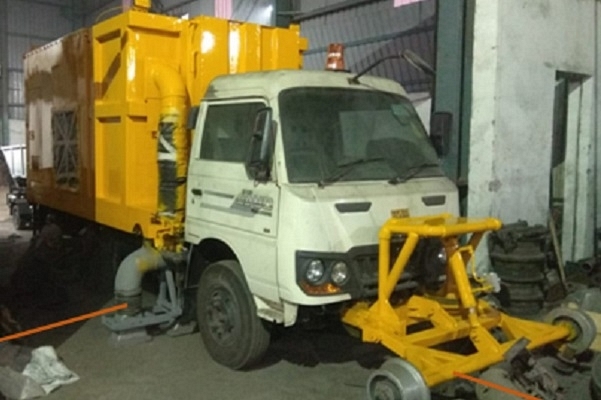News Brief
Bhopal Based Scientist Develops Railway Track Scavenging Vehicle, To Help In Replacing Manual Scavenging

Front view of the developed vehicle (PIB)
A self-propelled railway track scavenging vehicle may soon replace manual scavenging and cleaning that is still practiced to remove human waste lying on railway tracks.
Despite the ban on manual scavenging since 1993 in our country, men and women are seen removing excreta on the tracks with brooms and metal plates. Once the garbage is picked up from the tracks, night soil, excessive dirt, oil, and other foreign materials is ineffectively cleaned with high-pressure water jets.
Dr Sharad K Pradhan, Associate Professor, National Institute of Technical Teachers’ Training and Research (NITTTR), Bhopal, has developed a multifunctional railway track scavenging vehicle with support from the Advanced Manufacturing Technologies programme of the Department of Science and Technology (DST), Government of India aligned with the ‘Make in India’ initiative. A national patent has been published for this technology.
This self-propelled road cum rail vehicle equipped with dry and wet suction systems, air and water spraying nozzles, control system, and road cum rail attachment is multifunctional and easy to operate, the Ministry of Science and Technology said in a statement.
A display unit is provided for real-time control of the cleaning under a drastically changing environment. It requires only one person along with the driver to carry out the automatic cleaning of the railway track.
Once the dry and wet suction is over, the water nozzles start spraying water jets to clear off any human waste or semi-solid garbage present on the track floor.
Another set of nozzles spray disinfectants on the track to get rid of flies, rats, and other insects. Water jets completely remove the human waste and other wet garbage from the inter rail space zone.
Both dry and wet garbage are collected in different tanks, and once filled, it can be decanted at appropriate local municipal garbage collection points. A joystick-controlled telescoping suction pipe is fitted to clear the slurry from the trench parallel to the track.
After successful development and testing, the developed vehicle can be adopted by Indian railways as a scavenging vehicle for all of its stations.
Introducing ElectionsHQ + 50 Ground Reports Project
The 2024 elections might seem easy to guess, but there are some important questions that shouldn't be missed.
Do freebies still sway voters? Do people prioritise infrastructure when voting? How will Punjab vote?
The answers to these questions provide great insights into where we, as a country, are headed in the years to come.
Swarajya is starting a project with an aim to do 50 solid ground stories and a smart commentary service on WhatsApp, a one-of-a-kind. We'd love your support during this election season.
Click below to contribute.
Latest